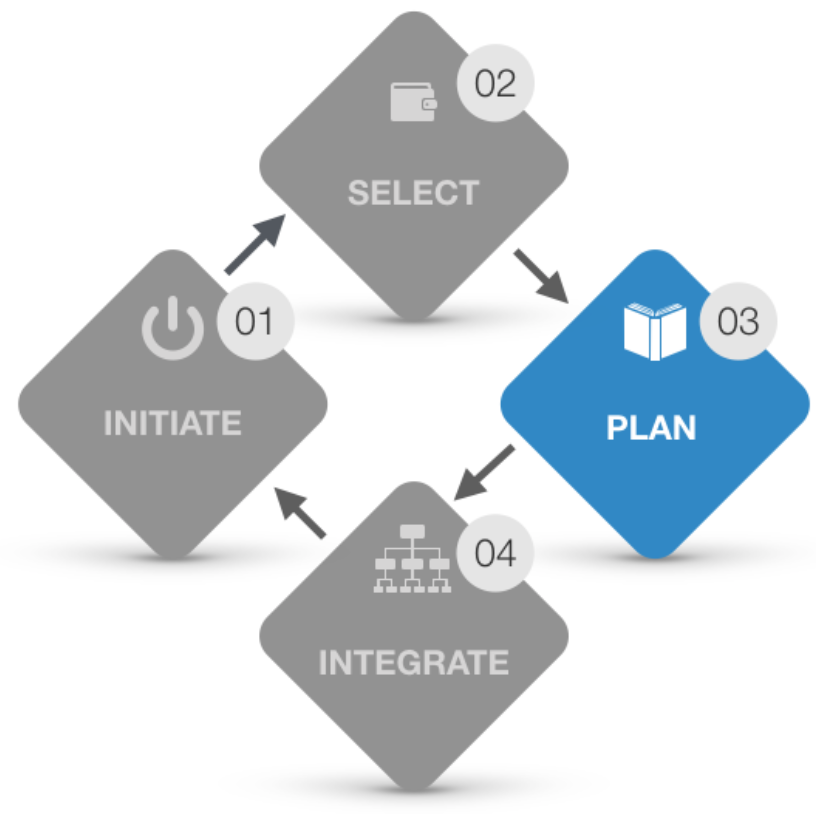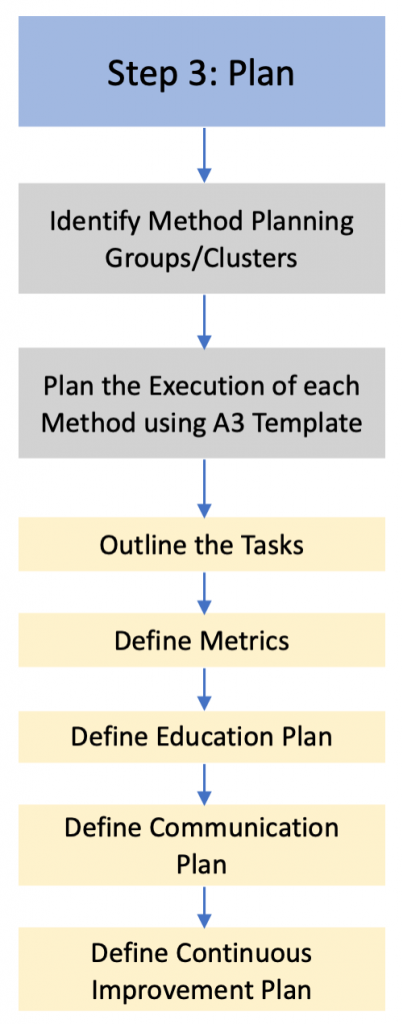5 Step 3: Plan
Defining the ‘How’, ‘When’, and ‘Who’
“Planning is bringing the future into the present so that you can do something about it now”
― Alan Lakein
Once the methods are selected for implementation, the project team should collaboratively develop the plan for each of the selected methods. It is strongly encouraged to develop these during the lean deployment planning kick-off and/or follow-up session(s). One page summaries of frequently used methods are included in Appendix B to help project teams learn about them and get started with planning. A method planning A3 template is also provided to guide the team in developing the targeted methods and record critical decisions regarding implementation. The planning step helps to translate the P-COS into an actionable plan that can be measured and improved throughout the project duration.
Method Planning Groups/Clusters
One of the best ways to plan for implementing the methods is to use the project team members as a key resource. Considering that every individual has unique experience and set of skills, in a group such experiences and skills are enhanced and can be used objectively to develop a plan for each of the selected methods.
During the planning session(s), the project team can be divided into smaller groups/clusters of three to five members, varying based on the number of workshop  participants. Each group can then use the one-page summaries and the A3 method planning template to develop a method-specific plan. The work clusters should ideally be cross-functional and comprise members from different member organizations. Each group can be planning for more than one method, depending on the number of groups in the room.
participants. Each group can then use the one-page summaries and the A3 method planning template to develop a method-specific plan. The work clusters should ideally be cross-functional and comprise members from different member organizations. Each group can be planning for more than one method, depending on the number of groups in the room.
Planning the Methods
The lean coach, along with the project leaders should facilitate the planning sessions. When groups review the method one-page summaries, the lean coach should be able to answer questions or help find answers collaboratively.
Even as groups work on the method plan, each group should appoint a leader or champion, who will be responsible to follow through with the plan or, nominate an individual or a group, who can be the method champion and assist with implementing the method along with tracking alignment.
As the project team goes through the planning process, the first step is to identify the project condition(s) of satisfaction (P-COS) that the method helps achieve or the specific purpose of implementing that method. Identifying the P-COS, will support with developing metrics that are truly indicative of progress and help the team stay focused on continuously improving during implementation. The method cluster needs to identify all the potential touch points of each specialty so that it can be planned accordingly factoring into the task-breakdown all such roles and responsibilities.
For each method being planned, the groups need to acknowledge other methods that are complementary in achieving similar P-COS. For example, using Set-based Design encourages the use of Choosing by Advantage to make a final design selection and both are included in the use of Target Value Design to manage scope and cost throughout the project duration. Therefore, all three methods can be developed in combination with each other and their task breakdowns will need to consider the points of intersection of roles and responsibilities. Having considered that, if a plan is being developed for all methods, it needs to be considered in the ‘Integrate’ step while developing a project level plan for implementation.
Going through the A3 Method Planning template, the project team needs to consider all of the above as they develop metrics, identify the needs for education and training, and develop the communication and continuous improvement plans. The page titled – Method Planning Process and A3 Template Instructions, further elaborates on which questions to consider during planning and how the template needs to be filled out to capture all critical planning information and decisions.
Methods Planning Process and A3 Template Instructions
Once the Lean methods are selected and analyzed, the project team can begin the implementation planning process. The planning can be assigned to be facilitated by Cluster Groups or the entire team. To support this process, a generic A3 Method Planning Template (Figure No. 9a & b, Appendix A) was developed to help the project team develop the method implementation plan in a systematic manner. Specific to each method, the appendix carries instruction sheets for the unique considerations, metrics, training, and communication needed to support the team’s discussion and decision-making process for each method. The
A3 template design is focused on capturing the method-level information and rolling it up to create a project-level plan. The directions for the template are split across two figures, Figure 9a and 9B, with the corresponding directions provided to the side.
Method: At least one method template should be developed per method. In some instances, such as the use of a method across phases, it may be helpful to refine or update the planning template to address the new contexts and team members when moving from design to construction.
Champion: The champion is the person, or sometimes cluster, responsible for ensuring the implementation and follow-through for the specific method. The champion should be someone engaged in the daily operations for the project.
Project (shown on Figure 9b): The project should be identified to clarify the targeted process. Also, once each project is complete, firms can compile methods references from multiple projects to support future teams – knowing the source project can be helpful to collect insights and advice from the project team.
Goal: The goal is intended to re-visit the specific project goal the team is targeting. It may also be valuable to capture the key risks or challenges that are associated with that goal if the method is targeted specifically to address those challenges.
Customer(s): The customers are those receiving the outputs of this method. Defining the customers, those that will either benefit from or will receive the output of the method, ensures that their needs are being explicitly met and value defined from their perspective(s).
Task Breakdown: The core of the A3 planning is defining the tasks that need to be performed for a given method. In the method summaries, found in Appendix C, there are method specific questions and suggestions to help a team define the necessary tasks and steps.
Identify related methods: Many of the methods suggested in the guide are complementary. The method summaries (Appendix C) provide indications of methods that are complementary or interdependent. This allows the project team to help map the relationships among the methods you have selected to implement.
Metrics: Data collection should be aligned with process to minimize effort and collect metrics or values from existing systems where possible. However, the metrics should not be subordinated to these systems, define the target measurements first, see how existing systems can be used, then add new metric collection as needed.
- Data Extraction from Project Management Systems
- Team Feedback (Interviews, Focus Groups, Plus Delta Reviews, etc.)
- Customer Satisfaction Survey
- Peer Reviews
- Other
Education Plan: One of the key challenges to successful implementation of any process or method is ensuring those responsible for it have the knowledge and skills necessary. This step focuses on identifying the education and training areas needed for the successful execution of the lean method(s). The levels of education and training should be reviewed and assessed at three levels. Who from the team needs to have a general understanding of the method (Introduction)? Who will be directly engaged in implementing or facilitating the use of a specific method (Deep Dive)? And who will take the lead in working toward mastering a method, to the level that they can serve as one of the trainers (Trainer)? Then the timing should be considered to support the Task Breakdown, and preferred options for how the training should be conducted should be captured.
Communication Plan: The communication plan focused on defining those who need to know and understand the implementation of the method, and how it can be captured and conveyed to them in a timely and effective manner.
- How will the team decide what needs to be communication and how frequently?
- How will the team confirm effective communication?
- How can the team leverage visual methods to communicate the plan?
Continuous Improvement: The key to continuous improvement is to constantly learn by measuring what has already been implemented and therefore, it is important that during implementation planning, the project team also decide the monitoring, reassessing, and learning approaches that can be beneficial on the specific project. To develop a thorough continuous improvement plan, the team can reflect on questions that help them put a plan in place:
Reflection Questions:
- How does the team want to design their project monitoring process?
- Which methods and/or techniques will support the project monitoring process?
- How will the team decide which metrics to follow and how frequently?
- How will the team couple learning with action to make a change when needed?

